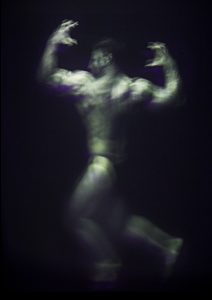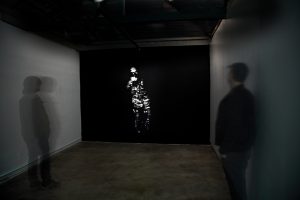


ESPAÇOS EXPOSITIVOS

2013

2013

2013

2013

2013

2013

2013
2013
DEMASIADO
Instalação
00:02:03
REAL ACTION
Vídeo
00:01:32

2013
Vídeo
00:01:30
Vídeo
00:01:30
Vídeo
00:01:30
Vídeo
00:01:30
There was a time when man saw the world as a combination of chaotic and violent forces that threatened his very existence. Unable to dominate them, he would turn to the possibility of experiencing extreme pleasure in abandoning himself to the unkind rituals dedicated to the god Dionysius. These forces had to be restrained by the good measures in the forms imposed by Apollo, so that a civilization process could be constituted and man could recognizes himself as a subject. In this effort to tame nature, tensions that continually haunt us were compressed.
That is the way in which excesses reappear in the bosom of modern civilization as a supposedly inoffensive effect, produced by technique itself. The excesses that mark new rituals – now transformed into spectacles, such as here, in the case of body building or war games – do not appear to have compromised the power that man has conquered, seeing that they are the result of his autonomous will. They represent only an increment to the conquered order, but not its disturbance. Definitely ascertained as a plastic or playful effect, the excesses are converted into value: there is neither a limit nor sufficiency for that which a society cultivates as beautiful or pleasurable.
Medicine is to the body of biology that which war is to the body of society: one and the other are interventions of culture over an organism in disarray. The analogy allows for an exchange of representations: war is justified as a bitter yet necessary remedy the same way as a medical treatment is thought of as a struggle against an enemy invader.
A healthy body and the battle have always been of interest to poetry, to painting and to sculpturing. This esthetic approach, however, was not disassociated from a moral dimension: gymnastics was represented as a character-forming discipline, the same way as war was intended to be an instrument of civilization. In this manner, both implied a certain ideal of justice. It is exactly when the body and war are reduced to a plastic and performing function that exaggeration becomes necessary: the excess of form is a manner in which to compensate the emptying-out of the psychological or social sense of the efforts expended.
Body building, even when against the backdrop of a medical speech, remains a cosmetic activity which does not aim at the body’s good functionality. On the contrary, this science is conducted in detriment to any notion of good health or organic efficiency. Its purpose is essentially to construct poses that allow the geometry of the muscles, already somewhat idealized by classic sculpturing, to be surpassed.
Paintball now, is, in a certain sense, war in a literally pictorial version in which paint, and not blood, represents death. As a game, it is less an exercise in strategy – as is, for example, chess – than one in dramatization. If there is one convincing expression in these soldiers, it is because they reproduce through their acting, dressing and scenery an imaginary war constructed overall by the cinema.
Even if we recognize archetypical traces in the performances that remain from the cult to the body or to war, what the practitioners seek is an effect which runs out in the present, in other words, in the presentation, the spectacle: it is therefore about a rite without a myth.
The work shown in this exhibition is evidence that part of what we call reality already exists in itself as a pose, regardless if it has been placed in front of a camera. However, we must not take these scenes as something simply exotic and distant. They depict the outmost situation of an experience that crosses our everyday life: representation is and has always been an element that makes up our social reality and it is impossible to live within a culture without playing roles. This requires that the question be thought out beyond the Manichean notions of truth and lies.
It is also evident to us that medicine demonstrates its efficiency in inventing a hybrid body, something between the normal and the artificial, with muscles, breasts, noses, skin but also with expressions, habits and behaviors that do little to translate our will or personality. In their turn, the gestures and vocabulary of war are assimilated in everyday study, work and social cohabitation relations. In an environment that makes competitiveness its main driving force any and all efficiency is measured in terms of the capacity to dominate an opponent. Therefore, the poses we see performed here in a hyperbolic manner are also part, in some manner, of the roles that are attributed to us.
In the installation shown in the Central Gallery, we see the heavy bodies of two body builders, a man and a woman, paradoxically supported by light and translucent fabric. Thusly, these dense and dilated bodies are evidence of their condition as an image: that which body building works on and constructs is in fact, nothing more than a surface. The photographs are projected with the intervention of a hospital apparatus: the image is reflected by a liquid medium, in principle neutral and translucent, which does not appear to affect the final image. However the same medical substance that reflects these bodies from time to time also destabilizes them with the effect of the dripping that disturbs the reflecting surface. We then recognize the inconsistency of these solid bodies that have been elaborated in their appearance by technique and that are, at the same time, devoid of functionality as an organism. In its capacity for manipulation, science turns the body itself into a liquid existence, capable of assuming planned forms that are not very compatible with its own nature. The photographs that complement these projections and that occupy the Fidalga Space merely reaffirm by their fixed nature the dilution of this body into an image in which only a pictorial effect, but not that of a subject, remains.
In the video that can also be found at the Fidalga Space, soldiers appear in a dark environment, first only as stains, later as camouflaged bodies in rigid, slowing movement, almost robotic. Sooner or later the mysterious and dramatic light, which adds tension to the performance, becomes insufficient to hide the artificiality of the pose, of the clothing and of the weapons. Yet the construction is quite realistic, not so much because we know about the reality of war, but because it corresponds to the treatment given the theme by the cinema, as we mentioned before. The video’s screen is that which, according to our average experience, mostly resembles a battlefield. But here lies a disturbance of the space: seen from a vertical angle, this field is no longer the scenery and becomes a picture itself, as war does not exist in any other territory other than this body that depicts it as a game.
Ronaldo Entler